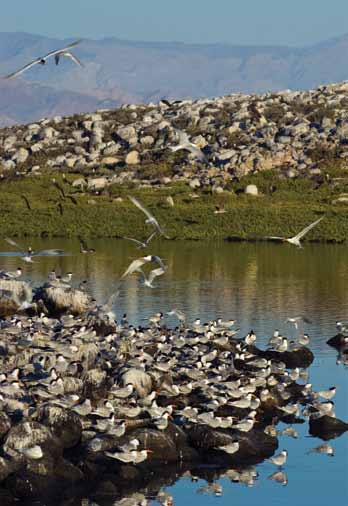Contents | 3 | 4 | 5 | 6 | 7 | 8 | 9 | 10 | 11 | 12 En español
Climate change affects birds and fisheries in the Gulf of California
By Ernesto Bolado Martínez*
With the El Niño effect present in the Pacific Ocean and the Gulf of California, 2009 was the fifth hottest year on record, according to the United Nations. As a result, nesting failed on Isla Rasa (off the coast of Baja California) for 95% of the world’s population of the Elegant Tern and Heermann's Gull.
Enriqueta Velarde (Ph.D.) from the University of Veracruz and Exequiel Ezcurra (Ph.D.) from the University of California, who have both studied these birds for the last 30 years, explain this occurrence in their educational video. When the  sea warms up, sardines, which are the birds’ primary food source, seek out deeper, colder water and are beyond the birds’ reach. As a result, the birds can’t feed their young and the hatchlings die.
sea warms up, sardines, which are the birds’ primary food source, seek out deeper, colder water and are beyond the birds’ reach. As a result, the birds can’t feed their young and the hatchlings die.
Sardines are also a food source for many commercial species that feed an important fishing industry in the Gulf of California region which reported a record catch of more than 600,000 tons during the 2008-2009 season. However, it looks like there will be a drastic loss during the current season.
The non-profit organization SuMar produced the educational video about this issue which will be distributed widely in local schools and television stations with the support of the citizen journalist network in Puerto Peñasco and Guaymas in Sonora, Teacapán in Sinaloa and San Blas in Nayarit. For more information email:*Director de SuMar
When nesting fails on Isla Rasa, it is a global disaster
Participation invited in activities related to CIP
By María de los Angeles Carvajal*
Information campaign launched in Sinaloa
The Autonomous University of Sinaloa (UAS), in conjunction with the non-profit organizations Conselva, Alcosta and SuMar, will launch an informational campaign next July in Escuinapa and Teacapán, Sinaloa. The goal is to spread awareness of the effects of large-scale tourism which is being promoted by Fonatur through its Integrally Planned Center (CIP) megatourism projects, with one such project already proposed for the south part of the state.
Fonatur submitted their Environmental Impact Report (EIR) for the CIP in Escuinapa to SEMARNAT. The campaign led by UAS and the non-profit organizations will focus on education  and on seeking opinions about the EIR from all sectors of the municipality.
and on seeking opinions about the EIR from all sectors of the municipality.
There are a number of CIPs throughout Mexico, with the closest example located in Los Cabos, Baja California Sur. Many clearly negative effects of that project have been brought to light, including: the excessive influx of migrants; loss of public beach access by the local community; wetland loss; significant lack of potable water and other basic services like sewage, infrastructure, schools and hospitals.
The campaign’s organizers invite the public to stay tuned for the coming actions, which include a theater piece, “The Last Ceviche” and informational workshops about the effects of large-scale tourism which will be presented at the same time as the EIR. This will allow the participants to voice their opinions regarding the EIR and also allow them to present their proposals to the appropriate authorities. For more information, contact: sumarvoces@gmail.com*Founding member of SuMar
The theater piece “The Last Ceviche” debuts soon in the region’s public plazas.